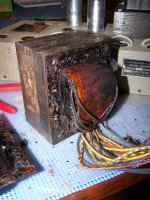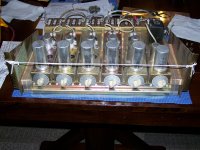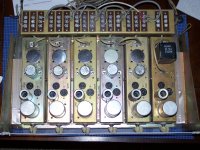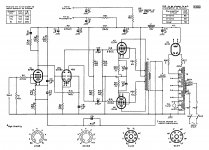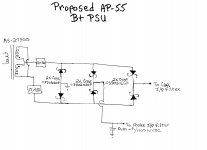I have come in to possession of two SC AP-55's and the matching 6ch preamp.
They were an absolute steal at $60 for the set.
There is an unknown problem with both amps but the explanation makes no sense.
Evidently something bad happened and it fried the power transformers.
That is about all of an explanation I got.
I will start by Ohming out the PT and hope for no shorts or opens.
I have a schematic and I'm hoping for the best.
A pair of PPP 6L6 amps would be nice.
They were an absolute steal at $60 for the set.
There is an unknown problem with both amps but the explanation makes no sense.
Evidently something bad happened and it fried the power transformers.
That is about all of an explanation I got.
I will start by Ohming out the PT and hope for no shorts or opens.
I have a schematic and I'm hoping for the best.
A pair of PPP 6L6 amps would be nice.
Fried Power Trannies?
NOW, I have seen my fair share of fried things in my life but !HOLY CRAPPP!
This is totally crispy.
I take it this is not common for even 60yr old power trannies to look like this.
Looks like new trannies are in order huh?
NOW, I have seen my fair share of fried things in my life but !HOLY CRAPPP!
This is totally crispy.
I take it this is not common for even 60yr old power trannies to look like this.
Looks like new trannies are in order huh?
Attachments
The next question is what would cause both power amps to have the same problem at the same time.
They were pulled from service as a pair.
They were pulled from service as a pair.
They stink bad, I have not completely finished all the cross short testing yet.
I pulled it from the chassis to make testing easier and I figured I would pull the endbells while I was at it.
They came off really easy for being so old.
I pulled it from the chassis to make testing easier and I figured I would pull the endbells while I was at it.
They came off really easy for being so old.
Attachments
The AP-55 schematic is interesting. Notice 3X 125 mA. 5Y3 rectifiers, 2 of which feed a cap I/P filtered 390 V. rail and the 3rd feeds a 290 V. choke I/P filtered rail.
If you SS rectify the B+ voltages, the $38.50 AnTek AS-2T300 looks like a suitable replacement for the "fried" power "iron".
No matter how you twist and turn, a lot of work has to be done in bringing those monoblocks up to a high performing level. I suggest you consider Mullard 5-20 style circuitry (schematic attached), using a 6SJ7 as the voltage amplifier and a 6N7 as the long tailed pair phase splitter. Use a 10M45S CCS in the LTP's tail, instead of a resistor.
If you SS rectify the B+ voltages, the $38.50 AnTek AS-2T300 looks like a suitable replacement for the "fried" power "iron".
No matter how you twist and turn, a lot of work has to be done in bringing those monoblocks up to a high performing level. I suggest you consider Mullard 5-20 style circuitry (schematic attached), using a 6SJ7 as the voltage amplifier and a 6N7 as the long tailed pair phase splitter. Use a 10M45S CCS in the LTP's tail, instead of a resistor.
Attachments
I sure would hate to part these old things out.
I might look into a set of Toroids to get the HV, 6.3V & 5V I need.
I have already come to the realization that this will be a very long term project since 2 full sets of tubes will be about $250.
Not to mention all the drifted resistors and 60yr old capacitors needing to be changed.
I might look into a set of Toroids to get the HV, 6.3V & 5V I need.
I have already come to the realization that this will be a very long term project since 2 full sets of tubes will be about $250.
Not to mention all the drifted resistors and 60yr old capacitors needing to be changed.
Oz series rectifiers are high failure parts, IMHO. I wouldn't put one back. If there is a selenium rectifier in the FM stage not shown running off the 15v , It also could have taken out the power transformer. Selenium was about a 10000 hour part - I caught mine just as they were getting leaky at 9 years of age, before they damaged anything. I put new selenium rectifiers in (no internet in those days) about 10 years they needed replacing again. The counter salesman told me I didn't want selenium, but he didn't explain how to buy cinch terminal strips to mount silicon diodes using screws. I had to figure that out by myself. I didn't want diodes connected to wires flying in the air in a big ball of electrical tape.
Last edited:
I might look into a set of Toroids to get the HV, 6.3V & 5V I need.
I don't think you will find off the shelf toroids with 5 VAC rectifier windings. SS rectify the B+ and use the Antek toroid I linked. The 5Y3 is directly heated and starts almost as fast as SS diodes start.
Jim McShane has electrically perfect, but tilted bottle, Russian 6П3С-E (6p3s-e) stock at $52.50 per matched quad. $105 takes care of the O/P tube needs of both monoblocks. 😀 RES shows 6N7s for $5 each and 6SJ7s for $4 each. Looks like less than $200 will buy the tubes needed to get both monoblocks "back on their feet".
I have my 6N7's and 6SN7's that I need for testing.
I was looking a 2 toroids one for the HV & 6.3 and the other to handle just 5V.
I was looking a 2 toroids one for the HV & 6.3 and the other to handle just 5V.
Forget vacuum rectification! It's easy enough to phase up the paired B+ windings on an AS-2T300 and bridge rectify with 600 PIV Schottky diodes. Use 5 A. diodes on the ground side of the bridge and combos of 3 A. and 2 A. parts on the "hot" side of the bridge. Doing so follows the OEM pattern and allows for a cap. I/P filtered and a choke I/P filtered rail. A couple of CL-150 inrush current limiting thermistors between the power transformer and the rectifier bridge will "soften" the B+ rails' rise.
You will place clamp mounted filter caps. in the openings currently occupied by rectifier tube sockets.
S/C used a paraphase splitter. For technical reasons, that topology has fallen out of favor. The "concertina" and long tailed pair topologies are what is currently well regarded. I suggested Mullard style circuitry, as it works well with O/P "iron" whose "pedigree" is questionable. The AP-55 sure looks like a PA amp to me, with O/P transformers of dubious "pedigree".
Any 6SN7s that are in good condition can be saved for a line stage project.
You will place clamp mounted filter caps. in the openings currently occupied by rectifier tube sockets.
S/C used a paraphase splitter. For technical reasons, that topology has fallen out of favor. The "concertina" and long tailed pair topologies are what is currently well regarded. I suggested Mullard style circuitry, as it works well with O/P "iron" whose "pedigree" is questionable. The AP-55 sure looks like a PA amp to me, with O/P transformers of dubious "pedigree".
Any 6SN7s that are in good condition can be saved for a line stage project.
Well, if you're into diy, you can add some turns to buck yourself back down to 5V if you insulate for the HT it will see. You can figure it out and there's room in the big Anteks if you think about the support and any undue pressure that may be exerted on a given section of winding. Ancient rule of thumb is clearance and creepage for full working voltage plus 1 kV but check your own rules out to be safe.
And yes, you have properly apprehended the cost of getting a Steal on some amps -- welcome to the next level and let this be a lesson to Run from Steals 😉
OTOH, now you're in it. It's just money and time. You get to choose what to do. You decide the objectives, you call the budget, and you set the schedule. That's pretty empowering stuff, right there. Remember to keep it fun or to not do it until it is again 😉
And yes, you have properly apprehended the cost of getting a Steal on some amps -- welcome to the next level and let this be a lesson to Run from Steals 😉
OTOH, now you're in it. It's just money and time. You get to choose what to do. You decide the objectives, you call the budget, and you set the schedule. That's pretty empowering stuff, right there. Remember to keep it fun or to not do it until it is again 😉
G/S,
As the sheet metal and O/P transformers are easily worth the $60 the OP laid out, this was not a situation to run away from. You are certainly correct in indicating time and money are the controlling factors in returning the pair of AP-55s to service.
As the sheet metal and O/P transformers are easily worth the $60 the OP laid out, this was not a situation to run away from. You are certainly correct in indicating time and money are the controlling factors in returning the pair of AP-55s to service.
I've uploaded a "hen scratch" version of the proposed SS rectified B+ PSU. The 0.01 μF. cap. in the choke I/P filter circuitry provides protection against inductive kick back spikes, which can destroy SS diodes. Not shown, but quite important, are ferrite beads on the primary wires. Toroids are wide bandwidth and crud riding on the AC mains needs to be suppressed. Mouser stocks the diodes, thermistors, and ferrite beads needed to execute this concept.
BTW, substantial increases in the amount of capacitance employed in the PSU filters is safe, when SS rectification is used. IMO, those increases are highly desirable.
BTW, substantial increases in the amount of capacitance employed in the PSU filters is safe, when SS rectification is used. IMO, those increases are highly desirable.
Attachments
You know, you can get those trafos rewound. The guy I use for power trafos is Gary Brown, he's at Transformer Rewinding Service
I do have the tubes Eli mentioned as well. They are excellent in 6L6 family circuits.
I do have the tubes Eli mentioned as well. They are excellent in 6L6 family circuits.
I have a feeling that having the transformers rewound will cost WAY more than a couple of Antek's and some diodes though.
I'd love to keep the thing original but I just don't think it's in the cards, plus toroids are less likely to create noise than the original.
I'd love to keep the thing original but I just don't think it's in the cards, plus toroids are less likely to create noise than the original.
Einrich
I have the 6550 version of those amps and one of mine had a bad power transformer when I got it. The power transformers in these commercial applications are made hefty and overbuilt but what many people neglect to realize is,a short circuit is a short circuit.
Overtime,people neglect to change filter caps and they all of a sudden become leaky and putting excess loading on the rectifier tubes and then the transformer..This is also happens in the case where the stripped bumblebee coupling caps weren't changed out..They start leaking DC voltage causing the output tubes to draw grid current,putting excess loading on the power and even output transformers.
Last but not least,many of these amps were used in outdoor applications..What is outdoors that we fight get out of many times in the summer and spring? Yes,humidity and rain..Do you have any idea what that can do to a transformer as they trap moisture inside their cores? Right again...They can take a royal dump..
I would check the transformers out but do it on a variac if you have one handy.
I have the 6550 version of those amps and one of mine had a bad power transformer when I got it. The power transformers in these commercial applications are made hefty and overbuilt but what many people neglect to realize is,a short circuit is a short circuit.
Overtime,people neglect to change filter caps and they all of a sudden become leaky and putting excess loading on the rectifier tubes and then the transformer..This is also happens in the case where the stripped bumblebee coupling caps weren't changed out..They start leaking DC voltage causing the output tubes to draw grid current,putting excess loading on the power and even output transformers.
Last but not least,many of these amps were used in outdoor applications..What is outdoors that we fight get out of many times in the summer and spring? Yes,humidity and rain..Do you have any idea what that can do to a transformer as they trap moisture inside their cores? Right again...They can take a royal dump..
I would check the transformers out but do it on a variac if you have one handy.
- Status
- Not open for further replies.
- Home
- Amplifiers
- Tubes / Valves
- Stromberg-Carlson AP-55

